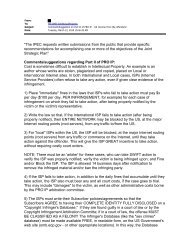We Energies Coal Combustion Products ... - The White House
We Energies Coal Combustion Products ... - The White House
We Energies Coal Combustion Products ... - The White House
Create successful ePaper yourself
Turn your PDF publications into a flip-book with our unique Google optimized e-Paper software.
Since lightweight concrete masonry is about 20% lighter than conventional<br />
masonry, it is easier to install and transport. Many users report fewer back<br />
injuries and fewer complaints due to repetitive motion ailments. Lightweight<br />
masonry units are slightly more expensive than conventional concrete<br />
masonry, but the cost of a typical wall made of lightweight masonry is<br />
generally less, due to increased productivity and lower transportation costs.<br />
<strong>The</strong> life cycle costs are less due to energy savings.<br />
Minergy LWA was also used for geotechnical applications. Lightweight<br />
backfill reduces the loads on poor sub-soils thus minimizing settlement.<br />
Lightweight backfill behind retaining walls exerts lateral pressures that are 3<br />
to 4 times less than conventional sand, stone or clay backfill. Typical backfill<br />
projects include highway embankments, bridge abutments, fill for road<br />
construction, segmental retaining walls, and lightweight fill for building<br />
structures.<br />
Minergy LWA was also used to produce lightweight soils for roof top gardens<br />
and parks such as McArthur Square in Milwaukee, Wisconsin and Monona<br />
Terrace in Madison, Wisconsin. <strong>The</strong> thermal resistivity of Minergy LWA was<br />
about 4 times higher than sand or stone and is often used to backfill water<br />
mains that do not have adequate cover or to insulate other frost susceptible<br />
structures. Lightweight aggregate can be used for perimeter insulation for<br />
slabs on grade and building foundations.<br />
<strong>The</strong> Minergy LWA manufacturing process had numerous environmental<br />
benefits. Historically, fly ash and sludge were landfilled at a substantial<br />
economic and environmental cost. By utilizing recycled ingredients, the<br />
Minergy LWA process not only prevents needless land filling but also<br />
eliminates the need for raw material extraction.<br />
Unlike conventional lightweight aggregate manufacturing processes that rely<br />
on a large amount of energy to power the process, the ash and sludge provided<br />
fuel for most of the plant's energy needs – minimizing the need to consume<br />
other resources. Since LWA concrete’s R-value (thermal resistivity) is two<br />
times higher than normal weight concrete, it can improve the energy<br />
efficiency of buildings in which it is applied.<br />
<strong>The</strong> plant was closed in November 2000 due to competitive pressures for<br />
sewage sludge, higher value uses for the fly ash, and to make room for<br />
additional generating facilities at the Oak Creek Power Plant.<br />
<strong>We</strong> <strong>Energies</strong> 230<br />
<strong>Coal</strong> <strong>Combustion</strong> <strong>Products</strong><br />
Utilization Handbook



